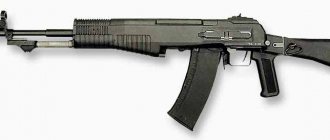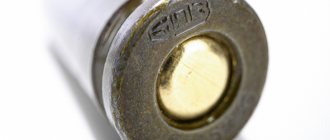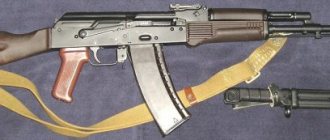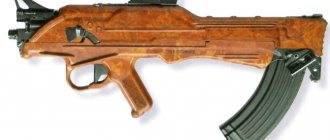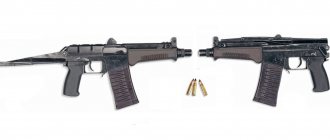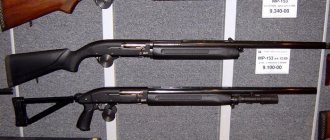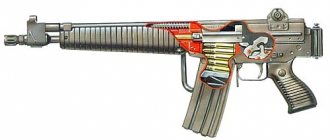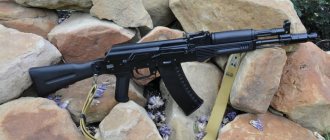| AEK-971 | |
| Type | Machine |
| A country | USSR |
| Service history | |
| Adopted | 1990 |
| In service | Ministry of Internal Affairs |
| Wars and conflicts | Second Chechen War |
| Production history | |
| Constructor | Koksharov, Stanislav Ivanovich |
| Designed by | 1978 |
| Manufacturer | Plant named after Degtyarev |
| Options | See options |
| Characteristics | |
| Weight, kg | 3.53 (without cartridges) 0.23 (empty AK74 magazine) 0.17 (empty light alloy AKM magazine) |
| Length, mm | 960 (with stock unfolded) 720 (with stock folded) |
| Barrel length, mm | 420 |
| Cartridge | 5.45×39 mm (AEK-971) 5.56×45 mm NATO (AEK-972) 7.62×39 mm (AEK-973) |
| Caliber, mm | 5.45 (AEK-971) 5.56 (AEK-972) 7.62 (AEK-973) |
| Work principles | removal of powder gases, butterfly valve, balanced automation[1] |
| Rate of fire, rounds/min | 900[2] |
| Initial bullet speed, m/s | 880 (AEK-971)[2] 850 (AEK-972) 730 (AEK-973)[1] |
| Sighting range, m | 500 |
| Maximum range, m | 1000[1] |
| Type of ammunition | box magazine for 30 rounds from AKM or AK74 (depending on caliber), it is possible to use box magazines for 45 rounds from RPK and RPK74 machine guns[1] |
| Aim | sector, there is a mount for installing various sights[1] |
| Media files on Wikimedia Commons | |
This term has other meanings, see AEK.
AEK-971
- a Soviet assault rifle developed in 1978 at the Degtyarev plant in Kovrov under the leadership of Stanislav Ivanovich Koksharov based on the Konstantinov system assault rifle (SA-006), which participated in the 1974 competition [1].
In 2013-2015, a modification of the AEK-971 called “A-545” took part in a competition for a new general-arms assault rifle[3]. In April 2015, the deputy chairman of the board of the Military-Industrial Commission announced that the machine gun would be put into service along with the AK-12[4].
History and biography of the machine
The AEK-971 was developed to participate in the 1978 Abakan competition, announced by the USSR Ministry of Defense, during which preference was given to the Nikonov assault rifle (AN-94, which later received its second name - Abakan). The original version differs from modern designs, since many innovations were perceived by the Ministry of Defense as unnecessary, which led to a simplification of the machine gun. In the 1990s, the machine gun was modified and produced in small quantities until 2006 for various Russian security services, after which production was transferred to the Degtyarev Plant. It should be noted that the abbreviation AEK has no decoding, being a factory index of a particular model. The production of machines at the new location is not carried out, since the deployment required significant costs, which will not be recouped without the receipt of large orders[1].
Prospects
The weapons are produced at the Degtyarev plant, which has extensive experience in weapons production. But it is noted that, despite all the positive characteristics of the Koksharov assault rifle, there are no particular prospects for it. Its use for arming line units is limited by its complexity and the rapidly declining quality of conscripts.
And its use in special-purpose units and elite “court” units does not provide prospects for development and further allocation of financial resources for its improvement.
Especially considering the position of the Kalashnikov Concern, which by hook or by crook is trying to push its models into service.
However, the current situation in the arms market, given that the stocks of low-impulse cartridges are huge, and the transfer of the army to a new cartridge-weapon complex is impossible, even in the USA, a country with significant industrial potential, will lead to a situation where the complex will be built on the introduction of a new model weapons.
The situation of the 1974 competition will be repeated, then the AK-74 was adopted as an “eternal” transitional model. What will be adopted today is still an unanswered question.
Design
The AEK-971 is made according to a traditional layout (front position of the magazine) and is structurally similar to a Kalashnikov assault rifle - it uses a rotating bolt and automatic reloading based on a gas engine, which is driven by powder gases exhausted through a gas outlet tube above the barrel. The machine gun is designed for 5.45x39 mm cartridges; there are also variants of this machine gun chambered for 5.56 mm NATO (AEK-972) and 7.62x39 mm (AEK-973). For food, standard magazines from AK74 (indexes 6L20 and 6L23) or AKM are used, depending on the caliber.
The automation circuit has been redesigned to eliminate one of the shortcomings of the Kalashnikov assault rifle - the insufficiently high accuracy of automatic fire, which is caused by the shaking of the assault rifle due to the movement of the bolt group when reloading each cartridge during the firing process. For this purpose, the AEK-971 implements a balanced automatic circuit based on a gas engine (a similar circuit was used in the later AK-107 and AK-108 assault rifles). A balancer has been added to the automation unit, corresponding in weight to the bolt group. The bolt frame and balancer are connected through racks and gears, the axis of which is fixed in the receiver. The frame and balancer pistons act as the front and rear walls of the gas chamber. At the moment of firing, under the pressure of powder gases, they begin to simultaneously move in opposite directions with equal speeds, and the impulses of their movement compensate each other. As a result, the displacement of the weapon caused by the operation of the automation is minimal. The accuracy of burst fire from unstable positions is noticeably improved, exceeding that of the AK74M by 1.5-2 times.
The body of the AEK-971 is metal, the fore-end, pistol grip and receiver guard are made of high-strength plastic. The fire mode switch safety box is located on both sides of the receiver (only the switch is on the left). The mechanism provides three firing modes: single, continuous bursts and bursts with a cut-off of 3 shots (in the early version the cut-off was 2 shots). The machine gun has seats for mounting a 6X4 bayonet and an under-barrel grenade launcher (GP-25 “Koster”, GP-30 “Obuvka” or GP-34). The sight is a sector one, similar to the AK74 sight; the sighting block is located in front of the receiver cover. The stock on the original version folded to the left, then it was replaced by a permanent stock, and in the modern version it folds to the right. The first model of the machine gun had a muzzle brake-compensator with the ability to change the holes (increase and decrease when firing from stable and unstable positions, respectively); in the later version it was replaced by the compensator from the AK74[1].
Characteristics
The burst accuracy characteristics of the late (simplified) version of the AEK-971 are improved by 15-20% in comparison with the AK74, and in comparison with the Nikonov assault rifle, worse accuracy of the second hit was revealed when firing in bursts, but better accuracy when firing in long bursts. The warranty life of the new machine gun is equal to that of the AK74 and amounts to 10,000 rounds[2]. Combat rate of fire is 40 rounds per minute when firing single shots and 100 rounds per minute when firing in bursts[1]. The rate of fire is 800-900 rounds per minute (in the early version - about 1500 rounds per minute) in both automatic modes (unlike the AN-94 Abakan, which has a much higher rate when firing with a burst burst). The muzzle energy for the 5.45 mm caliber is about 1500 J at an initial bullet speed of 880 m/s, for the 7.62 mm it is about 2200 J.
Performance characteristics of competitors AK-74M, AN-94, AK-12 and A-545
| Characteristics | AK-74M | AN-94 | AK-12 | A-545 |
| Weight, empty/curb, kg | 3,6/3,9 | 3,6/3,9 | 3,2/3,6 | 3,4/3,8 |
| Barrel length, mm | 415 | 415 | 415 | 415 |
| Initial bullet speed, m/sec | 900 | 900 | 900 | 900 |
| Rate of fire, rds/min | 600 | 1800/900 | 650 | 900 |
| Overall length, stock extended/folded | 704/943 | 728/943 | 730/940 | 720/960 |
| Body kit, shops | standard | standard | standard | standard |
In terms of technical indicators, the assault rifles are almost equal, but the devil is in the details, so the AN-94 works on the principle of a displaced recoil impulse. This allows you to fire two bullets in one position of the weapon, only after which the recoil impulse jerks the barrel of the machine gun, while its rate of fire is 1800 rounds/min. In normal mode, its rate of fire is 900 rounds, which is higher than that of Kalashnikov assault rifles.
But the accuracy of automatic fire is approximately the same. The A-545 is a little heavier, but on the other hand it has excellent shooting accuracy. The AK-12's internal structure almost completely corresponds to the AK-74M; its main difference is a bunch of beautiful decorations and Picatinny rails hung on it by Zlobin's designers. Although some experts talk about increased accuracy due to the weight of the barrel and changes in ergonomics.
But, in my opinion, these changes are insignificant, and they will not be able to influence the shooting accuracy of a conscript soldier to any large extent.
The A-545 assault rifle, its technical characteristics are at a height unattainable for competitors, the AK-107 could compete with it, but I’m afraid that the designers of Izhmash and the Kalashnikov concern froze its development in favor of the Zlobin AK-12.
Options
- AEK-971
- basic version chambered for 5.45x39 mm (GRAU Index -
6P67
).
It has a modification of the A-545
(with minimal changes), adopted for service. - AEK-972
is a variant of the AEK-971 chambered for the 5.56x45mm NATO cartridge. - AEK-973
is a variant of AEK-971 chambered for 7.62x39 mm (GRAU Index -
6P68
), uses AKM magazines.
It has a modification of the A-762
(with minimal changes), adopted for service. - AEK-973S
is a variant of the AEK-973, with a retractable telescopic butt, a modified shape and angle of the pistol grip[1].
Modifications
Cord
5.45-mm Kord assault rifle (6P67) at the Oboronexpo 2014 exhibition.
The Kord assault rifle[5] was created to participate in the competition for a new combined arms assault rifle[6]. Passed state tests in 2014 on the “Warrior” theme together with the AK-12 of the Kalashnikov concern, satisfying all the tactical and technical requirements of the Ministry of Defense of the Russian Federation. During tests, the 6P67 showed better accuracy when firing in long bursts, but was inferior in terms of price-quality ratio[7][8][9][10]. Based on the test results, it was decided to accept both assault rifles for military service during 2015[11][12].
It is distinguished from the base model, first of all, by a different design of the receiver (on the AEK-971 there is a removable cover), which allows you to attach a Picatinny rail to the machine gun for the possibility of installing various sights and a fire mode switch on both sides of the machine gun.
As of the beginning of 2022, testing of four assault rifles continued at the “3rd Central Research Institute of the Ministry of Defense”: AK-12, AK-15, 6P67 and 6P68[13].
In January 2022, the 6P67 and 6P68 assault rifles were adopted by the Russian Special Operations Forces, while the competing AK-12 and AK-15 assault rifles were adopted as general-arms assault rifles. According to available data, during testing, the 6P67 showed, compared to the AK-12, approximately 10% higher efficiency (probability of hitting a target) at a range of up to 300 meters, but 10% lower efficiency at a range of more than 300 meters, mainly due to worse than the AK-12, accuracy of fire with single shots[14].
The 6P68 variant of the assault rifle uses a 7.62×39 mm cartridge[15].
Ammunition
For firing all of the above types of weapons, standard army cartridges, which are in service with the RA, are accepted. First of all, this is a 5.45x39 mm caliber cartridge. This ammunition has a number of advantages over the earlier “seven” (7.62 mm model 1943). Among the advantages of the cartridge it is worth noting:
- flat trajectory, long range of a direct shot, in other words, this is a shot in which the height of the trajectory does not exceed the height of the target;
- greater carryable ammunition, if the carryable reserve of the “seven” is 300 rounds, then for 5.45 mm – 440 rounds and more;
- the high flight speed of the bullet, 5.45 mm, allows the target to make much fewer body movements in the interval between the shot and the hit, in addition, this will allow for less lead.
Despite these advantages, 7.62x39 mm also has its own advantages that the low-impulse cartridge does not have. So, for example, a normal silent complex has not yet been developed for the 5.45 mm caliber, while for the 7.62 mm PBBS and the US cartridge, bullets of which have subsonic speed, are quite widely produced. In addition, the “seven” has a significant assortment of bullets for various purposes, which cannot be said about the “five”.
Well-known myths about a 7.62x39mm bullet piercing rails lengthwise, shooting battleships and tanks from a machine gun with BZ bullets can safely be considered myths, as well as stories about 5.45mm bullets being deflected by reeds and branches.
It should be noted that disputes about the effectiveness of 5.45 and 7.62 mm machine gun bullets were born out of nowhere, and, as a rule, are subjective. Both calibers kill equally effectively. Unless, of course, we talk about hunting use, in this case 7.62 mm is more profitable economically and in use.
Notes
- ↑ 12345678910
Description of AEK-971 on weapon.at.ua - ↑ 1 2 3
description of AEK-971 on the manufacturer’s website
(unspecified)
(inaccessible link). Access date: July 29, 2009. Archived February 27, 2009. - AK-12 and A-545 assault rifles (GRAU Index - 6P67
) passed state tests - Ilya Shchegolev - Rossiyskaya Gazeta - Deputy Chairman of the Military-Industrial Complex: The Russian Ministry of Defense will arm itself with both the AK-12 and the Degtyarev assault rifle (unspecified)
. - Automatic KORD 6P67 (undefined)
. Rosoboronexport. Access date: September 21, 2022. - Izhevsk Concern "Kalashnikov" and the Degtyarev plant started an information war? // TVNZ
- BREAKING: Russian Army Accepts Both AK-12 And AEK-971
- A fresh Kalashnikov captured the troops (unspecified)
. - The military prefers the Izhevsk AK-12 as the weapon for the “Warrior”
- Both the new Kalashnikov assault rifle and its competitor passed tests for the “Ratnik”. Business newspaper "Vzglyad"
- Dmitry Semizorov, General Director of TsNIITOCHMASH. 09 February 2015
- Completion of tests of small arms and grenade launchers for the Russian army, ITAR-TASS.
- TV channel "Star". Military acceptance. "Closed Test Center"
- Automatic AEK-971 6P67 6P67 6P68 (Russia) - Modern Firearms (Russian), Modern Firearms
(October 27, 2010). Retrieved June 19, 2022. - Weapons for “Ratnik”: what will replace the “Kalashnikov”?
